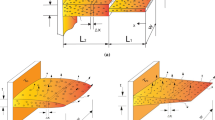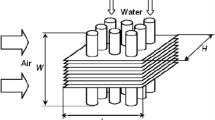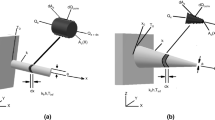Abstract
A heat dissipation model of a rectangular porous fin is established based on constructal theory. First, the constructal design of rectangular porous fin is conducted by selecting a complex function minimization, which composed of linear weighting sum of maximum temperature difference and pumping power consumption, as optimization objective. Effects of gap height, air inlet velocity, total porous fin volume and porosity on the optimal constructs are investigated, respectively. The findings show that the complex function can attain its double minimum at a value of 0.802 when the fin length and number are optimized, and the corresponding optimal fin length and number are 8.01 mm and 10, respectively. In comparison to original design, the complex function and maximum temperature difference after twice optimization are decreased by 19.80% and 66.31%, respectively. Second, the comprehensive performance of porous fin is improved by simultaneously optimizing the fin length and number. The artificial neural network is applied to predict the fin performances, which is used to conduct multi-objective optimization based on NSGA-II algorithm. Optimal structure of porous fin for multiple requirements is gained by LINMAP and TOPSIS decision-making strategies. The findings in this study can serve as theoretical guides for fin thermal designs of electronic devices.
Similar content being viewed by others
References
van Erp R, Soleimanzadeh R, Nela L, et al. Co-designing electronics with microfluidics for more sustainable cooling. Nature, 2020, 585: 211–216
Lohrasbi S, Hammer R, Essl W, et al. A comprehensive review on the core thermal management improvement concepts in power electronics. IEEE Access, 2020, 8: 166880–166906
Wang L, Xie Z H, Chen L G, et al. Equivalent thermal resistance minimization for a circular disc heat sink with reverting microchannels based on constructal theory and entransy theory. Sci China Tech Sci, 2021, 64: 111–121
Chen C, You J, Feng H J, et al. A multi-objective study on the constructal design of non-uniform heat generating disc cooled by radial- and dendritic-pattern cooling channels. Sci China Tech Sci, 2021, 64: 729–744
Yao X L, Shi Q L, Liu Q, et al. An investigation on application potentiality of microstructure heat sinks with different flow topological morphology. Sci China Tech Sci, 2022, 65: 2895–2909
Zhou J H, Chen X M, Li Q. Numerical study on two-phase boiling heat transfer performance of interrupted microchannel heat sinks. Sci China Tech Sci, 2022, 65: 679–692
Wang X Y, Xu X H, Liang X G. Enhancement of laminar flow heat transfer with single/double-inclined ribs for unilaterally-heated channel. Sci China Tech Sci, 2023, 66: 2108–2118
Yan K, Wang Y Y, Pan Y, et al. Topology optimization of simplified convective heat transfer problems using the finite volume method. Sci China Tech Sci, 2023, 66: 1352–1364
Cao X, Chen Y P. Design and numerical analysis of serpentine microchannel integrated with inner-wall ridges for enhanced droplet mixing. Sci China Tech Sci, 2023, 66: 560–573
Yang H X, Zhang G H, Dou B L, et al. The regulation mechanism and heat transfer enhancement of composite mixed paraffin and copper foam phase change materials. Sci China Tech Sci, 2023, 66: 2346–2360
Fang X Y, Nong X L, Liao Z R, et al. A novel preheating method for the Li-ion battery using supercooled phase change materials. Sci China Tech Sci, 2023, 66: 193–203
Fathi M, Heyhat M M, Zabetian Targhi M, et al. Porous-fin microchannel heat sinks for future micro-electronics cooling. Int J Heat Mass Transfer, 2023, 202: 123662
Kim S Y, Paek J W, Kang B H. Flow and heat transfer correlations for porous fin in a plate-fin heat exchanger. J Heat Transfer, 2000, 122: 572–578
Badruddin I A, Zainal Z A, Narayana P A A, et al. Heat transfer by radiation and natural convection through a vertical annulus embedded in porous medium. Int Commun Heat Mass Transfer, 2006, 33: 500–507
Naidu S V, Dharma Rao V, Sarma P K, et al. Performance of a circular fin in a cylindrical porous enclosure. Int Commun Heat Mass Transfer, 2004, 31: 1209–1218
Varol Y, Oztop H F, Varol A. Effects of thin fin on natural convection in porous triangular enclosures. Int J Thermal Sci, 2007, 46: 1033–1045
Makinde O D, Aziz A. MHD mixed convection from a vertical plate embedded in a porous medium with a convective boundary condition. Int J Thermal Sci, 2010, 49: 1813–1820
Taklifi A, Aghanajafi C, Akrami H. The effect of MHD on a porous fin attached to a vertical isothermal surface. Transp Porous Media, 2010, 85: 215–231
Gorla R S R, Bakier A Y. Thermal analysis of natural convection and radiation in porous fins. Int Commun Heat Mass Transfer, 2011, 38: 638–645
Kundu B, Bhanja D. An analytical prediction for performance and optimum design analysis of porous fins. Int J Refrig, 2011, 34: 337–352
Kundu B, Lee K S. A proper analytical analysis of annular step porous fins for determining maximum heat transfer. Energy Convers Manage, 2016, 110: 469–480
Sowmya G, Gireesha B J, Berrehal H. An unsteady thermal investigation of a wetted longitudinal porous fin of different profiles. J Therm Anal Calorim, 2021, 143: 2463–2474
Hosseinzadeh S, Hosseinzadeh K, Hasibi A, et al. Thermal analysis of moving porous fin wetted by hybrid nanofluid with trapezoidal, concave parabolic and convex cross sections. Case Stud Therm Eng, 2022, 30: 101757
Jain A, Abbas M M, Torabi M. Steady state thermal analysis of a porous fin with radially outwards fluid flow. Int J Heat Mass Transfer, 2023, 209: 124109
Hashemi A S, Heydari M, Loghmani G B. Iterative compact finite difference method for the numerical study of fully wet porous fins with different profile shapes. Appl Numer Math, 2023, 186: 358–377
Bejan A. Street network theory of organization in nature. J Adv Transport, 1996, 30: 85–107
Bejan A. Constructal-theory network of conducting paths for cooling a heat generating volume. Int J Heat Mass Transfer, 1997, 40: 799–816
Bejan A. Shape and structure, from engineering to nature. Entropy, 2001, 3: 293–294
Lorenzini G, Moretti S, Conti A. Fin Shape Thermal Optimization Using Bejan’s Constructal Theory. San Francisco: Morgan & Claypool Publishers, 2011
Chen L G. Progress in study on constructal theory and its applications. Sci China Tech Sci, 2012, 55: 802–820
Chen L, Feng H, Xie Z, et al. Progress of constructal theory in China over the past decade. Int J Heat Mass Transfer, 2019, 130: 393–419
Chen L G, Yang A B, Feng H J, et al. Constructal design progress for eight types of heat sinks. Sci China Tech Sci, 2020, 63: 879–911
Chen L G, Wu W J, Feng H J. Constructal Design for Heat Conduction. London: Book Publisher International, 2021
Bejan A. Heat Transfer: Evolution, Design and Performance. New York: John Wiley & Sons, 2022
Feng H, Chen L, Ge Y. Constructal optimization of a rectangular non-uniform heat generation area with irregular high thermal conductivity material. Case Studies Thermal Eng, 2023, 49: 103403
Bejan A. Constructal design evolution versus topology optimization. Int Commun Heat Mass Transfer, 2023, 141: 106567
Almogbel M, Bejan A. Cylindrical trees of pin fins. Int J Heat Mass Transfer, 2000, 43: 4285–4297
Lorenzini G, Rocha L A O. Constructal design of T-Y assembly of fins for an optimized heat removal. Int J Heat Mass Transfer, 2009, 52: 1458–1463
Bello-Ochende T, Meyer J P, Bejan A. Constructal multi-scale pin-fins. Int J Heat Mass Transfer, 2010, 53: 2773–2779
Lorenzini G, Corrêa R L, Domingues dos Santos E, et al. Constructal design of complex assembly of fins. J Heat Transfer, 2011, 133: 081902
Hajmohammadi M R, Poozesh S, Nourazar S S. Constructal design of multiple heat sources in a square-shaped fin. J Process Mech Eng, 2012, 226: 324–336
Chen L, Yang A, Xie Z, et al. Constructal entropy generation rate minimization for cylindrical pin-fin heat sinks. Int J Thermal Sci, 2017, 111: 168–174
Cong R, Ozaki Y, Machado B, et al. Constructal design of a rectangular fin in a mixed convective confined environment. Inventions, 2018, 3: 27
Barik A K, Swain P K. Constructal invasion of fins for melting time prediction of a phase change material in a triplex-tube heat exchanger. J Energy Storage, 2022, 54: 105281
Ahmed H H, Bhanja D, Nath S. Computational study to predict the thermal performance and optimal design parameters of a T-shaped fin subjected to natural convection. J Process Mech Eng, 2023, 237: 1235–1248
Hajabdollahi H, Shafiey Dehaj M, Masoumpour B, et al. Optimal design analysis of a tubular heat exchanger network with extended surfaces using multi-objective constructal optimization. Front Energy, 2023, 16: 862–875
Bhanja D, Kundu B. Heat transfer and fin performance comparison between constructal T-shaped porous and solid fin. AIP Conf Proc, 2010, 1298: 122–128
Bhanja D, Kundu B. Thermal analysis of a constructal T-shaped porous fin with radiation effects. Int J Refrig, 2011, 34: 1483–1496
Hazarika S A, Deshamukhya T, Bhanja D, et al. Thermal analysis of a constructal T-shaped porous fin with simultaneous heat and mass transfer. Chin J Chem Eng, 2017, 25: 1121–1136
Li F, Zhu W, He H. Numerical optimization on microchannel flow and heat transfer performance based on field synergy principle. Int J Heat Mass Transfer, 2019, 130: 375–385
Li F, Ma Q, Xin G, et al. Heat transfer and flow characteristics of microchannels with solid and porous ribs. Appl Thermal Eng, 2020, 178: 115639
Gulotta T, Guarino F, Cellura M, et al. Constructal law optimization of a boiler. Int J Heat Tech, 2017, 35: 297–305
Feng H, Chen L, Xie Z, et al. Multi-objective constructal design for a marine boiler considering entropy generation rate and power consumption. Energy Rep, 2022, 8: 1519–1527
Feng H, Zhang Z, Chen L, et al. Constructal design for tree-shaped compound heat transfer channel in a disc heat generation body. Int Commun Heat Mass Transfer, 2022, 132: 105929
Feng H, Sun K, Chen L, et al. Constructal design of a nanofluid cooling channel with sidewall ribs and cavities in a rectangular heat generation body. Case Stud Thermal Eng, 2023, 41: 102640
Wang J, Sun Z, Dai Y, et al. Parametric optimization design for supercritical CO2 power cycle using genetic algorithm and artificial neural network. Appl Energy, 2010, 87: 1317–1324
Rashidi M M, Galanis N, Nazari F, et al. Parametric analysis and optimization of regenerative Clausius and organic Rankine cycles with two feedwater heaters using artificial bees colony and artificial neural network. Energy, 2011, 36: 5728–5740
Lee H, Kang M, Jung K W, et al. An artificial neural network model for predicting frictional pressure drop in micro-pin fin heat sink. Appl Thermal Eng, 2021, 194: 117012
Polat M E, Cadirci S. Artificial neural network model and multi-objective optimization of microchannel heat sinks with diamond-shaped pin fins. Int J Heat Mass Transfer, 2022, 194: 123015
Shi S, Ge Y, Chen L, et al. Performance optimizations with single-, bi-, tri-, and quadru-objective for irreversible atkinson cycle with nonlinear variation of working fluid’s specific heat. Energies, 2021, 14: 4175
Yu C, Zhu X, Li Z, et al. Optimization of elliptical pin-fin microchannel heat sink based on artificial neural network. Int J Heat Mass Transfer, 2023, 205: 123928
Deb K, Pratap A, Agarwal S, et al. A fast and elitist multiobjective genetic algorithm: NSGA-II. IEEE Trans Evol Computat, 2002, 6: 182–197
Zhang L, Chen L, Xia S, et al. Multi-objective optimization for helium-heated reverse water gas shift reactor by using NSGA-II. Int J Heat Mass Transfer, 2020, 148: 119025
Tang C, Chen L, Feng H, et al. Four-objective optimizations for an improved irreversible closed modified simple brayton cycle. Entropy, 2021, 23: 282
Chen L G, Li P L, Xia S J, et al. Multi-objective optimization for membrane reactor for steam methane reforming heated by molten salt. Sci China Tech Sci, 2022, 65: 1396–1414
Zang P, Ge Y, Chen L, et al. Power density characteristic analysis and multi-objective optimization of an irreversible porous medium engine cycle. Case Studies Thermal Eng, 2022, 35: 102154
Li P, Chen L, Xia S, et al. Multi-objective optimal configurations of a membrane reactor for steam methane reforming. Energy Rep, 2022, 8: 527–538
Ge Y, Shi S, Chen L, et al. Power density analysis and multi-objective optimization for an irreversible dual cycle. J Non-Equilibr Thermodyn, 2022, 47: 289–309
Xu H, Chen L, Ge Y, et al. Multi-objective optimization of Stirling heat engine with various heat and mechanical losses. Energy, 2022, 256: 124699
Zhu H, Chen L, Ge Y, et al. Multi-objective constructal design for quadrilateral heat generation body with vein-shaped high thermal conductivity channel. Entropy, 2022, 24: 1403
Zhu H, Chen L, Ge Y, et al. Multi-objective constructal design for square heat-generation body with “arrow-shaped” high-thermal-conductivity channel. Energies, 2022, 15: 5235
Jin Q, Xia S J, Li P L, et al. Multi-objective performance optimization of regenerative S−CO2 Brayton cycle based on neural network prediction. Energy Convers Manage, 2022, 14: 100203
Yang W, Feng H, Chen L, et al. Power and efficiency optimizations of a simple irreversible supercritical organic Rankine cycle. Energy, 2023, 278: 127755
Chen X, Li X, Pan M, et al. Superstructure-free synthesis and multi-objective optimization of supercritical CO2 cycles. Energy Convers Manage, 2023, 284: 116966
Jaiswal A K, Afzal A. Design optimization of prismatic rib turbulators in a rectangular channel based on multi-objective criterion. Int J Thermal Sci, 2023, 185: 108091
Wang D, Zhang H, Wang G, et al. Experimental and numerical study on the heat transfer and flow characteristics of convex plate heat exchanger based on multi-objective optimization. Int J Heat Mass Transfer, 2023, 202: 123755
Wang W D, Wang W Q, Yang C, et al. A multi-objective power flow optimization control strategy for a power split plug-in hybrid electric vehicle using game theory. Sci China Tech Sci, 2021, 64: 2718–2728
Han H G, Zhang L L, Hou Y, et al. Adaptive candidate estimation-assisted multi-objective particle swarm optimization. Sci China Tech Sci, 2022, 65: 1685–1699
Mohtaram S, Wu W D, Aryanfar Y, et al. Multi-objective evolutionary optimization and thermodynamics performance assessment of a novel time-dependent solar Li-Br absorption refrigeration cycle. Sci China Tech Sci, 2022, 65: 2703–2722
Liu T X, Zheng Z M, Qin Y L, et al. New operation strategy and multi-objective optimization of hybrid solar-fuel CCHP system with fuel thermochemical conversion and source-loads matching. Sci China Tech Sci, 2023, 66: 528–547
Tang W, Feng H, Chen L, et al. Constructal design for a boiler economizer. Energy, 2021, 223: 120013
Chen L, Shi S, Ge Y, et al. Ecological function performance analysis and multi-objective optimization for an endoreversible four-reservoir chemical pump. Energy, 2023, 282: 128717
Chen L, Shi S, Ge Y, et al. Power density performances and multi-objective optimizations for an irreversible Otto cycle with five specific heat models of working fluid. Energy, 2023, 282: 128817
Author information
Authors and Affiliations
Corresponding author
Additional information
This work was supported by the National Natural Science Foundation of China (Grant No. 52171317) and Graduate Innovative Fund of Wuhan Institute of Technology (Grant No. CX2022070).
Rights and permissions
About this article
Cite this article
Liu, X., Feng, H., Chen, L. et al. Constructal design of a rectangular porous fin considering minimization of maximum temperature difference and pumping power consumption. Sci. China Technol. Sci. 67, 919–929 (2024). https://doi.org/10.1007/s11431-023-2495-y
Received:
Accepted:
Published:
Issue Date:
DOI: https://doi.org/10.1007/s11431-023-2495-y




